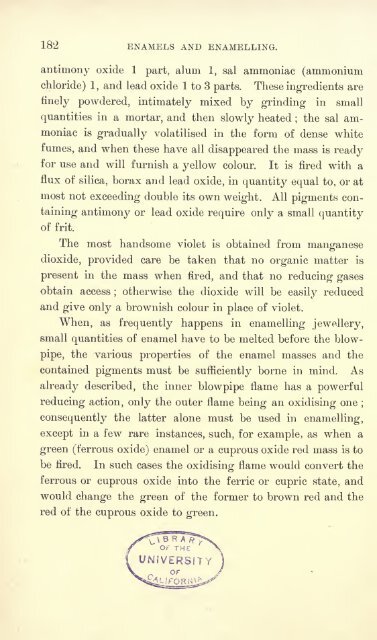Enamels and enamelling; an introduction to the preparation and ...
Enamels and enamelling; an introduction to the preparation and ...
Enamels and enamelling; an introduction to the preparation and ...
You also want an ePaper? Increase the reach of your titles
YUMPU automatically turns print PDFs into web optimized ePapers that Google loves.
18 k<br />
2 ENAMELS AND ENAMELLING.<br />
<strong>an</strong>timony<br />
oxide 1<br />
part, alum 1, sal ammoniac (ammonium<br />
chloride) 1, <strong><strong>an</strong>d</strong> lead oxide 1 <strong>to</strong> 3 parts. These ingredients are<br />
finely powdered, intimately mixed by grinding in small<br />
qu<strong>an</strong>tities in a mortar, <strong><strong>an</strong>d</strong> <strong>the</strong>n slowly heated ; <strong>the</strong> sal ammoniac<br />
is gradually volatilised in <strong>the</strong> form of dense white<br />
fumes, <strong><strong>an</strong>d</strong> when <strong>the</strong>se have all disappeared <strong>the</strong> mass is ready<br />
for use <strong><strong>an</strong>d</strong> will furnish a yellow colour. It is fired with a<br />
flux of silica, borax <strong><strong>an</strong>d</strong> lead oxide, in qu<strong>an</strong>tity equal <strong>to</strong>, or at<br />
most not exceeding double its own weight. All pigments con-<br />
taining <strong>an</strong>timony or lead oxide require only a small qu<strong>an</strong>tity<br />
of frit.<br />
The most h<strong><strong>an</strong>d</strong>some violet is obtained from m<strong>an</strong>g<strong>an</strong>ese<br />
dioxide, provided care be taken that no org<strong>an</strong>ic matter is<br />
present in <strong>the</strong> mass when fired, <strong><strong>an</strong>d</strong> that no reducing gases<br />
obtain access ; o<strong>the</strong>rwise <strong>the</strong> dioxide will be easily reduced<br />
<strong><strong>an</strong>d</strong> give only a brownish colour in place of violet.<br />
When, as frequently happens in <strong>enamelling</strong> jewellery,<br />
small qu<strong>an</strong>tities of enamel have <strong>to</strong> be melted before <strong>the</strong> blow-<br />
pipe, <strong>the</strong> various properties of <strong>the</strong> enamel masses <strong><strong>an</strong>d</strong> <strong>the</strong><br />
contained pigments must be sufficiently borne in mind. As<br />
already described, <strong>the</strong> inner blowpipe flame has a powerful<br />
reducing action, only <strong>the</strong> outer flame being <strong>an</strong> oxidising one ;<br />
consequently <strong>the</strong> latter alone must be used in <strong>enamelling</strong>,<br />
except in a few rare inst<strong>an</strong>ces, such, for example, as when a<br />
green (ferrous oxide) enamel or a cuprous<br />
oxide red mass is <strong>to</strong><br />
be fired. In such cases <strong>the</strong> oxidising flame would convert <strong>the</strong><br />
ferrous or cuprous oxide in<strong>to</strong> <strong>the</strong> ferric or cupric state, <strong><strong>an</strong>d</strong><br />
would ch<strong>an</strong>ge <strong>the</strong> green of <strong>the</strong> former <strong>to</strong> brown red <strong><strong>an</strong>d</strong> <strong>the</strong><br />
red of <strong>the</strong> cuprous oxide <strong>to</strong> green.<br />
or THE<br />
UNIVERSITY<br />
OF
















